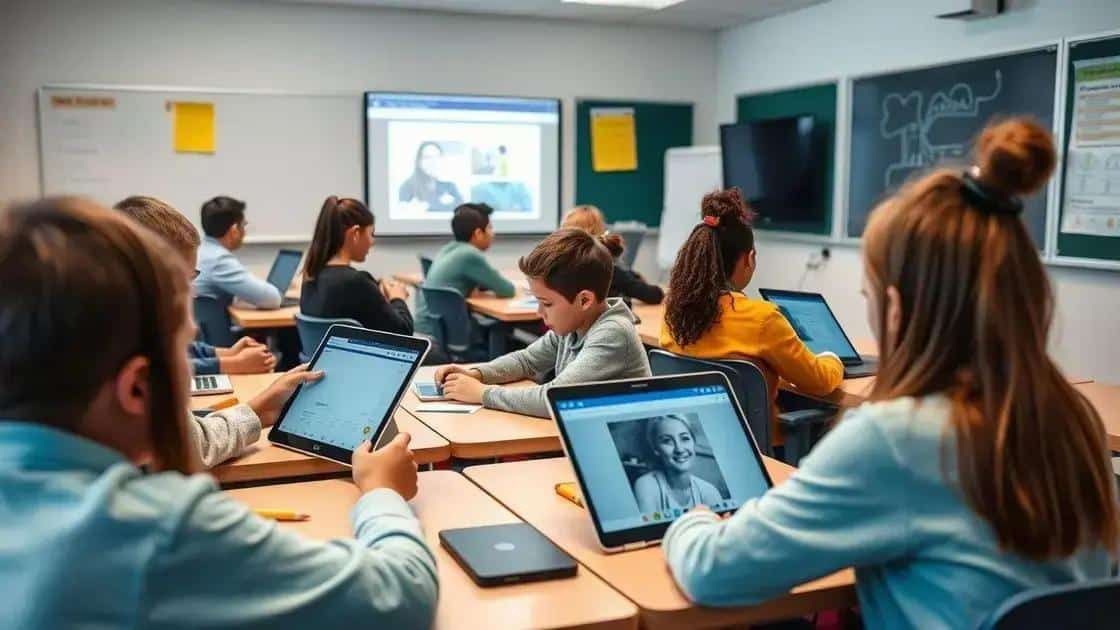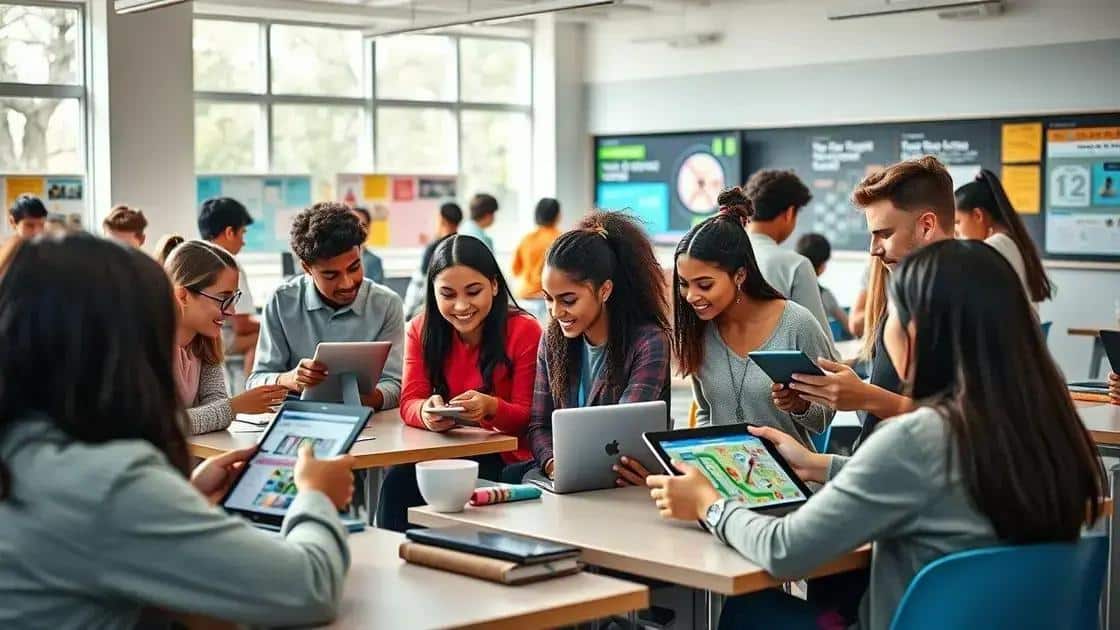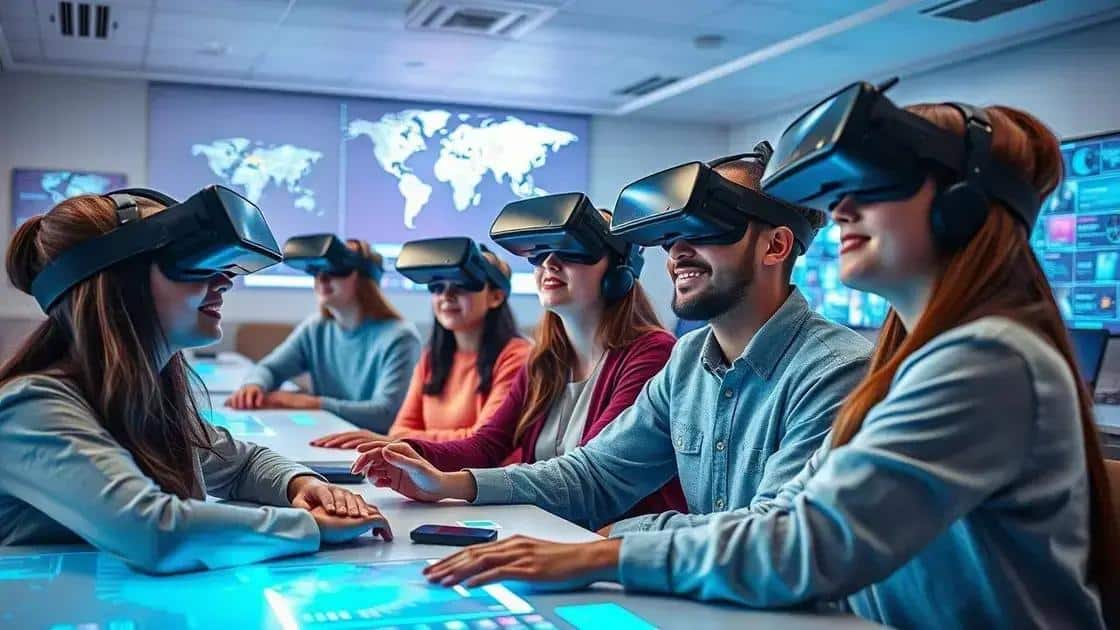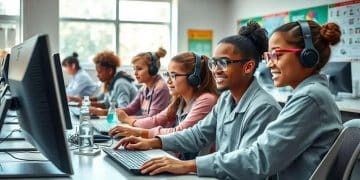School technology integration trends that redefine learning

School technology integration trends are revolutionizing education through personalized learning, immersive virtual experiences, and enhanced global collaboration, addressing both challenges and opportunities for educators and students.
School technology integration trends are transforming how students learn and interact with educational content. Whether it’s leveraging virtual reality for immersive experiences or using platforms that foster collaboration, technology is at the forefront of modern education. Ready to dive into the latest trends?
Emerging technologies shaping classrooms
Emerging technologies are dramatically reshaping classrooms today. Schools are increasingly adopting new tools that enhance learning and engagement. Understanding how these innovations impact education is crucial for teachers, students, and parents alike.
Interactive Learning Tools
One of the significant shifts in classrooms is the use of interactive learning tools. These include smart boards and student response systems that allow for real-time feedback. Through interactivity, educators can engage students more effectively, making lessons lively and fun.
- Smart boards enable touch interactions and multimedia presentations.
- Student response systems gather instant answers from students.
- Gamification encourages friendly competition in learning.
Moreover, virtual reality (VR) and augmented reality (AR) have begun to take center stage. These technologies let students experience immersive learning environments. For instance, they can explore historical sites or conduct scientific experiments in a virtual setting. This hands-on experience is often more impactful than traditional methods.
Cloud-Based Learning Platforms
Another key development is the rise of cloud-based learning platforms. These platforms facilitate collaboration among students and teachers regardless of their physical locations. Students can access resources anytime, making learning more flexible.
- Cloud storage ensures that everyone has access to the same materials.
- Collaboration tools allow for group projects without the need for physical meetings.
- Teachers can track progress and provide feedback seamlessly.
As these emerging technologies continue to grow, it’s important for schools to adapt. Educators must stay informed about the latest trends and be willing to integrate them into their teaching strategies. This ongoing adaptation will ensure that students are prepared for the demands of a digital world.
Benefits of integrating technology in schools

Integrating technology in schools brings numerous advantages that enhance learning experiences. This integration supports both teachers and students by introducing innovative methods that make education more interactive and engaging.
Enhanced Engagement
One major benefit of technology is the increased engagement it fosters among students. Interactive lessons using digital tools captivate learners’ attention, making them more enthusiastic about their studies. For instance, gamified learning platforms motivate students to participate actively in their education.
- Interactive media helps in maintaining student interest.
- Gamification promotes friendly competition and collaboration.
- Visual aids can simplify complex concepts.
Moreover, technology allows students to learn at their own pace. With access to online resources and tutorials, they can revisit challenging topics whenever needed. This personalized learning experience is vital in catering to different learning styles and abilities.
Improved Collaboration
Another significant advantage is improved collaboration. Technology enables students to work together seamlessly, whether inside or outside the classroom. They can share ideas and projects using various online tools.
- Collaborative software facilitates group projects.
- Cloud storage allows students to access materials from anywhere.
- Communication tools enhance interaction among peers and teachers.
As students collaborate using technology, they also develop important skills like communication and teamwork. These skills are essential for future success in both academic and professional settings. Overall, the benefits of integrating technology in schools are profound, providing essential support for modern education.
Challenges educators face with technology
While technology offers vast benefits for education, educators often face challenges when integrating it into their classrooms. Understanding these challenges helps in finding effective solutions that enhance the learning experience for students.
Technical Issues
One of the primary challenges is dealing with technical issues. Problems such as software glitches or hardware failures can disrupt lessons and create frustration. Teachers may spend valuable time troubleshooting instead of focusing on instruction.
- Frequent updates on software can lead to confusion.
- Not all students have access to devices at home.
- Network connectivity issues can hinder online learning.
Additionally, the pace of technological change can be overwhelming. Educators must continually learn about new tools and platforms, which can feel like a full-time job.
Training and Support
Another significant challenge is the lack of training and support for teachers. Many educators may not be comfortable using new technologies or may not receive adequate professional development. Without proper training, the potential of technology is often not fully realized.
- Teachers need hands-on experience to feel confident.
- Ongoing support is crucial for effective technology integration.
- Peer mentoring can enhance learning among educators.
Moreover, the varied skill levels among students add another layer of complexity. Teachers must adapt their lessons to accommodate both tech-savvy learners and those who struggle with technology. This balancing act can be time-consuming and challenging. Nonetheless, addressing these challenges is vital for successfully integrating technology in schools. By recognizing and finding solutions to these issues, educators can create a more effective and engaging learning environment for their students.
Future predictions for school technology

The future predictions for school technology are exciting and transformative. As innovations continue to emerge, educators and students will experience profound changes in how learning occurs.
Increased Personalization
One of the significant trends expected is the increased personalization of education. With the help of artificial intelligence, learning experiences can be tailored to meet the individual needs of students. AI can analyze student performance to create customized learning plans that target their strengths and weaknesses.
- Adaptive learning platforms adjust content based on student interactions.
- Personalized feedback helps students improve continuously.
- Learning analytics provide insights on student progress.
This level of personalization can lead to more effective learning outcomes. Students will feel more motivated and engaged, as the material becomes relevant to their interests.
Virtual and Augmented Realities
Another exciting prediction is the greater use of virtual reality (VR) and augmented reality (AR) in classrooms. These technologies can create immersive learning experiences. For example, students can take virtual field trips to historical sites or perform virtual science experiments that would be impossible in the real world.
- VR allows for exploration of 3D environments.
- AR enhances real-world learning with digital overlays.
- Both technologies encourage hands-on learning.
As these technologies become more accessible and affordable, their integration in classrooms will likely expand. Teachers can use them to capture students’ attention and enhance learning through experience.
Collaboration Beyond Borders
The future will also see enhanced collaboration among students globally. Technology will remove geographical barriers, allowing students to work together regardless of their location. This collaborative environment will foster cultural exchange and global awareness.
- Online platforms will facilitate international projects.
- Students will learn about diverse perspectives through teamwork.
- Language barriers may diminish through translation tools.
By preparing students to work in such a collaborative and connected world, schools will help them develop essential skills for the future job market. As school technology continues to evolve, the potential to enrich educational experiences will only grow.
FAQ – Frequently Asked Questions about School Technology Integration
What are the main benefits of integrating technology in schools?
Integrating technology enhances student engagement, supports personalized learning, and improves collaboration among students.
What challenges do educators face with technology in the classroom?
Teachers often encounter technical issues, lack of training, and varying student skill levels when using new technologies.
How can virtual and augmented reality be used in education?
VR and AR can provide immersive learning experiences, allowing students to explore environments and concepts in a hands-on way.
What future trends are expected in school technology?
Future trends include increased personalization, the use of VR/AR, and greater global collaboration through digital platforms.





